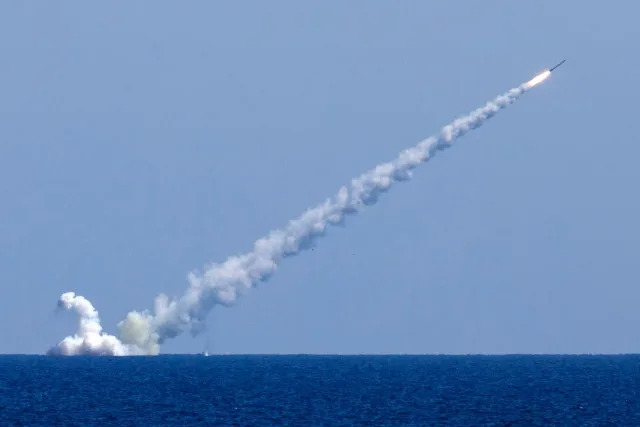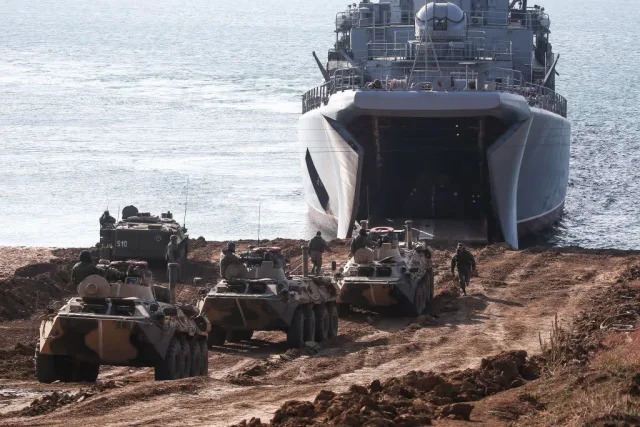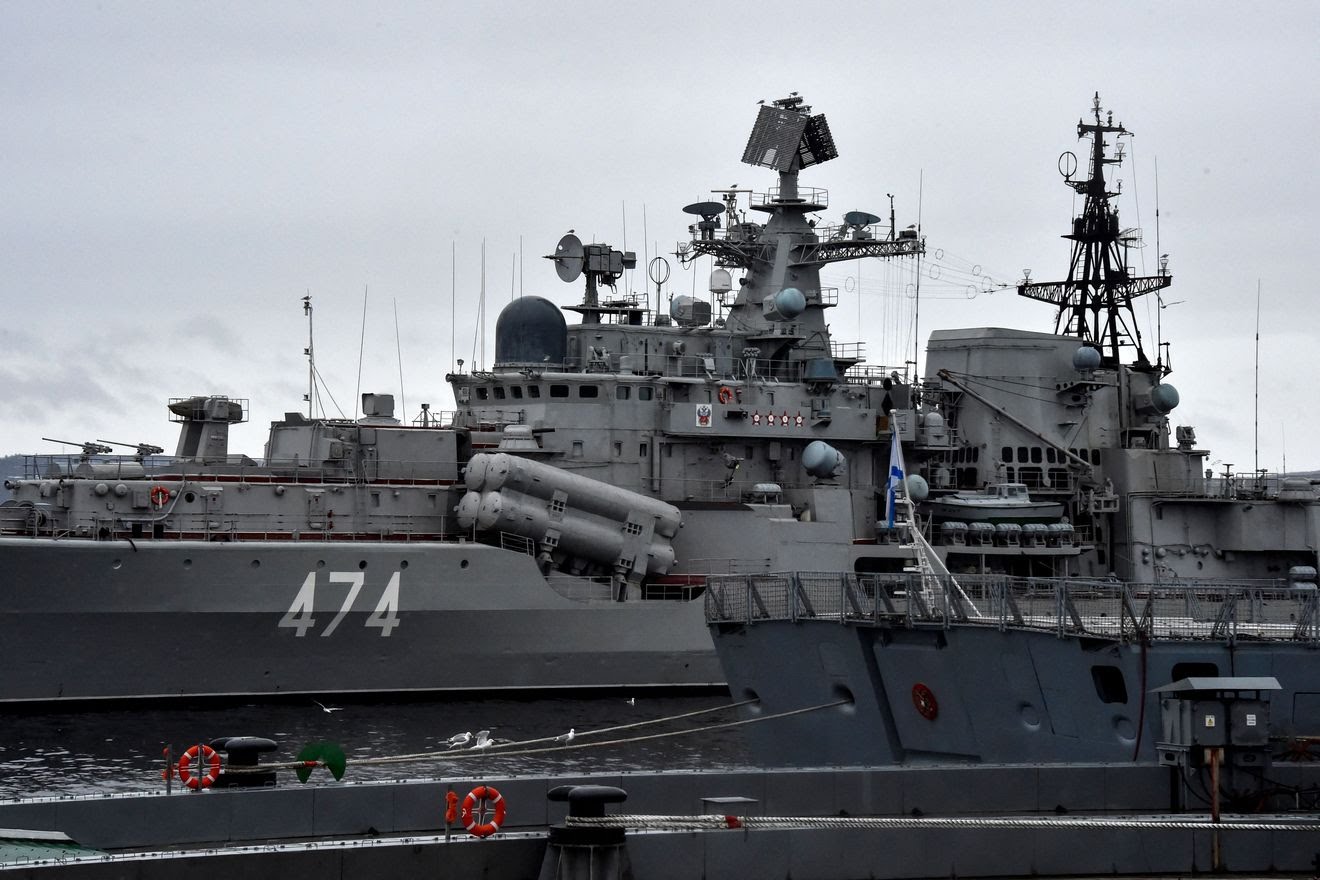Kyle Mizokami, POPULAR MECHANICS
- Russian warships, including amphibious transports capable of carrying marines, are massing in the Mediterranean and Black Seas.
- Those naval deployments—coupled with massing ground troops, numbering over 100,000—mean Russia has fortified every side of Ukraine that it possibly can.
- Russian naval infantry forces could now initiate landings along Ukraine’s coastline or tie up Ukrainian forces waiting for landings.
The Russian Navy has been surging naval units into the crisis zone surrounding Ukraine over the past few weeks, specifically in the Black Sea and Mediterranean. Not only is this one of the largest displays of naval power since the Cold War, but it’s also a sign that Russia could invade Ukraine by sea; even merely threatening to do so could pin down thousands of Ukrainian troops who would be forced to leave their posts and defend the coastline instead.
Traveling from as far away as the Pacific Ocean, the units could attack Ukraine with both precision cruise-missile strikes and amphibious invasions. Those cruisers, submarines, and warships could also pose a threat to Western naval forces; they have the potential to block NATO military intervention in the event of a Russo-Ukrainian War—something that National Security Advisor Jake Sullivan says is a “very distinct possibility.”
“We are in the window when an invasion could begin at any time should Vladimir Putin decide to order it,” Sullivan told reporters during a White House press briefing on Friday afternoon. “It could begin during the Olympics.” (The Winter Olympics in China end on February 20). Sullivan also warned Americans to evacuate Ukraine within the next 48 hours, but would not comment on a news report that Russian President Vladimir Putin has already given the green light to invade Ukraine next week.
It Moscow does intend to start a war, its presence at sea could be a major blow to Ukrainian forces. Russia has assembled a robust naval force with “surface groups from the Atlantic, Pacific, and Baltic fleets,” according to a recent update from H.I. Sutton, a naval authority and author of the popular Covert Shores blog.
Each task force is centered around a Slava-class guided-missile cruiser and one or more escorting destroyers. One group, centered around the cruiser Marshal Ustinov, is in the western Mediterranean, traveling east. Another, centered around the Pacific Fleet cruiser Varyag, recently traveled north through the Suez Canal and is expected to remain in the eastern Mediterranean.

A third group, led by the cruiser Moskva, is in the Black Sea, making it closest to Ukraine; however, it is expected to travel south into the Mediterranean, according to Sutton. Russia also has five Kilo-class coastal submarines armed with land-attack cruise missiles in the eastern Mediterranean and the Black Sea, and has assembled a strong force of amphibious transport ships from as far away as the Baltic Fleet.
Still, “this is the last great ride of Russia’s creaky, Cold War-era surface navy,” Craig Hooper—a maritime security analyst at the Thermistocles Advisory Group, a think tank that specializes in naval matters—tells Popular Mechanics.
While the Russian naval force is old—the cruisers, destroyers, and amphibious ships are all nearing 40 years of service—it remains vigorous. Varyag, Marshal Ustinov, and Moskva were built during the Cold War to hunt down U.S. aircraft carriers at sea and are equipped with 16 P-500 Bazal’t anti-ship missiles each. Bazal’t is a very large anti-ship missile (about the size of a small bus), packing either a one-ton, high-explosive warhead or a nuclear warhead. It travels at up to Mach 2.5 and has a range of 344 miles.
The force of six submarines is slightly younger, a mix of both older and newer Project 636 Kilo-class diesel electric-powered attack submarines. The newest sighted sub, Rostov-on-Don, was commissioned in 2015 and that year launched 3M14 Kalibr cruise missile strikes against terrorist targets in Syria. Kalibr, similar to the American Tomahawk missile, is a subsonic cruise missile with a 1,000-pound, high-explosive warhead and a range of up to 1,500 miles. The three Black Sea submarines are, according to Sutton, all “in port at last sighting, but understood to be ‘bombed up,’ including Kalibr missiles.”

Hooper says that slinging cruise missiles at distant targets fits with Russian’s tactic of bombardment. “Russia depends upon massed artillery, and the land-attack variants of the Kalibr missile are just an extension of that, particularly if Russia gets bogged down in urban areas and has trouble getting artillery munitions to the front lines.”
Perhaps the most ominous Russian naval deployment, from the Ukrainian perspective, is the concentration of 11 amphibious ships in the Black Sea. Six of those ships recently completed a long voyage from their home ports in the Northern and Baltic Seas, traveling down through the North Atlantic, across the Mediterranean, and then the Straits of Bosphorus under the cover of darkness. Many of those ships were already loaded with Russian naval infantry (the Russian equivalent of the U.S. Marine Corps), while others could embark naval infantry, armored personnel carriers, and tanks from ports on the Black Sea.

This multifaceted force, while lacking an aircraft carrier, presents Putin with many options. The submarine fleet lacks a Ukrainian navy to fight, but actions in Syria have shown Russia also considers them long-range cruise missile platforms. Kilo submarines in the eastern Mediterranean can strike targets as far away as the Ukrainian capital of Kyiv with precision, making it largely irrelevant whether the submarines enter the Black Sea. The three surface task forces, with their anti-ship missiles, could operate in the eastern Mediterranean, isolating the Black Sea and Ukraine, while threatening any NATO naval forces that enter the region.
The most important option the assembled Russian flotilla presents is the ability to land Russian naval infantry along Ukraine’s coast. The 11 transports are individually smaller than the U.S. Navy’s hulking amphibious ships, but could land a force of 3,000 to 4,000 troops, as well as accompany armored vehicles along Ukraine’s hundreds of miles of coastline. This force could be landed in support of an overland invasion.

Putin might not use his marines at all, though. In 1991, during Operation Desert Storm, U.S. Navy transport ships and a landing force of 7,000 Marines remained afloat in the Persian Gulf but never actually landed. The threat of a landing forced the Iraqi Army to defend the coastline, fixing in place several divisions it could have shifted to fight Coalition ground forces approaching from Saudi Arabia. The landing force effectively tied up an enemy force several times its own size. Putin’s Marines, a minimal force that could not sustain a drive into Ukraine, could accomplish more by threatening to stage an amphibious invasion instead of actually conducting one.
Nobody but Putin really knows if Russia will attack Ukraine. But if he does, his assembled, aging fleet can support the larger land invasion raging farther north. Russia might not even have to fire a shot to achieve its strategic goals. But if it does, its power could be a formidable challenge to NATO—and be felt as far north as the Ukrainian capital itself.














